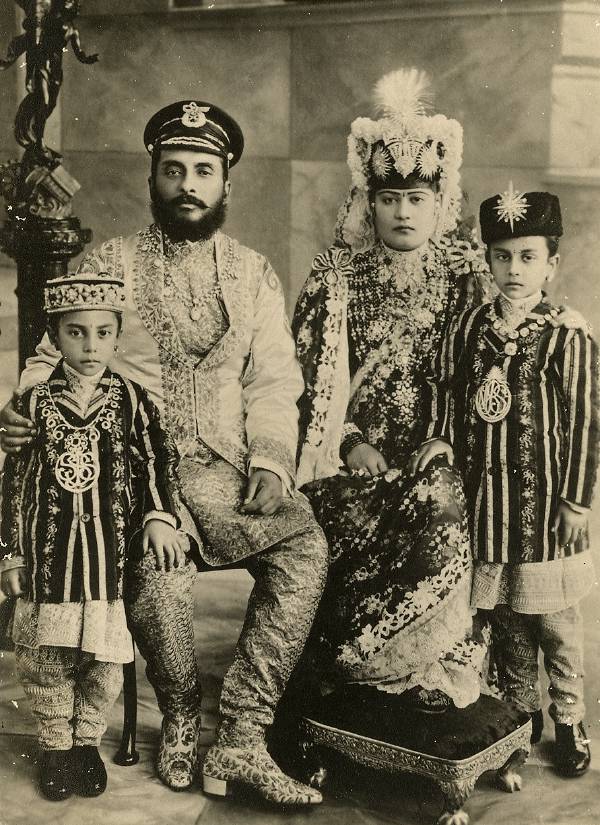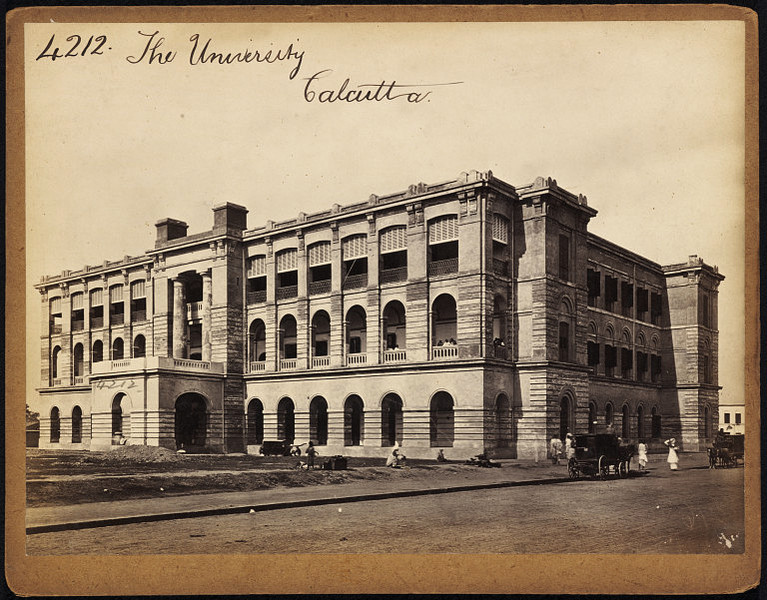|
Chandra Shumsher Jang Bahadur Rana
Field-Marshal His Highness Maharaja Sri Teen Chandra Shumsher Jung Bahadur Rana (8 July 1863 – 26 November 1929) was the Prime Minister of Nepal from the Rana dynasty. He served in this capacity from 27 June 1901 to his death in 1929 after he successfully deposed his liberal and reformist brother Dev Shamsher. Although generally perceived as despotic and conservative, he is credited with several reforms including the abolition of slavery and establishing the Nepal-Britain Treaty of 1923, which recognised Nepal as an independent nation and an ally of Britain. Family and early life Chandra Shumsher was the sixth of the seventeen sons of Dhir Shumsher Rana (the youngest brother of the Rana dynasty founder Jung Bahadur Rana) through his Thapa wife Nanda Kumari, of whom he was the third son. He was educated in Kolkata and thus became the first Nepalese Prime Minister who had passed matriculation examination. In the convocation address of 1884, the Vice Chancellor of Calcutta ... [...More Info...] [...Related Items...] OR: [Wikipedia] [Google] [Baidu] |
Field Marshal
Field marshal (or field-marshal, abbreviated as FM) is the most senior military rank, senior to the general officer ranks. Usually, it is the highest rank in an army (in countries without the rank of Generalissimo), and as such, few persons are ever appointed to it. It is considered as a five-star rank (OF-10) in modern-day armed forces in many countries. Promotion to the rank of field marshal in many countries historically required extraordinary military achievement by a general (a wartime victory). However, the rank has also been used as a Division (military), divisional command rank and as a brigade command rank. Examples of the different uses of the rank include Afghanistan, Austria-Hungary, India, Pakistan, Prussia/Germany and Sri Lanka for an extraordinary achievement; Spain and Mexico for a divisional command (); and France, Portugal and Brazil for a brigade command (, ). Origins The origin of the term dates to the early Middle Ages, originally meaning the keeper of t ... [...More Info...] [...Related Items...] OR: [Wikipedia] [Google] [Baidu] |
Prime Minister Of Nepal
The prime minister of Nepal (ISO 15919, ISO: ) is the head of government of Nepal. The prime minister leads the Council of Ministers of Nepal, Council of Ministers and holds the chief executive authority in the country. They must maintain the confidence of the House of Representatives (Nepal), Pratinidhi Sabha to remain in office. The prime minister is formally appointed by the President of Nepal but must command majority support in the Pratinidhi Sabha. If the prime minister loses this support, they are required to resign. The official residence of the prime minister is located in Baluwatar, Kathmandu. The seat of the prime minister's office has been at Singha Durbar, Singha Darbar since the tenure of Chandra Shamsher Jung Bahadur Rana. The current prime minister is KP Sharma Oli of the Communist Party of Nepal (Unified Marxist–Leninist), CPN (UML), who has held office since 15 July 2024. He was appointed by the President of Nepal, President Ram Chandra Poudel in acco ... [...More Info...] [...Related Items...] OR: [Wikipedia] [Google] [Baidu] |
Ranodip Singh Kunwar
Ranaudip Singh Bahadur Kunwar Ranaji (alternatively spelled Rana Uddip, Renaudip or Ranoddip), KCSI (3 April 1825 – 22 November 1885), commonly known as Ranodip Singh Kunwar () was the second Prime Minister of Nepal from the Rana dynasty. His style was His Excellency Commanding General Shree Shree Shree Maharaja Sir. Deeply pious, Ranodip Singh composed several devotional hymns and was granted a personal salute of 15 guns from the British in 1883 and the title of Tung-ling-ping-ma-kuo-kang-wang (Truly Valiant Prince; commander of foot and horse) from the Guangxu Emperor in 1882. He was born as seventh son of Kaji Bal Narsingh Kunwar from his second wife Ganesh Kumari Thapa, daughter of Thapa Kazi General Nain Singh Thapa. Succession As per the family roll of succession, Ranodip Singh succeeded his elder brother Jang Bahadur following his death in 1877. Coup and assassination Failed coup attempt of 1882 Chautariya Colonel Ambar Bikram Shah (son of General ... [...More Info...] [...Related Items...] OR: [Wikipedia] [Google] [Baidu] |
Bhim Shumsher Jung Bahadur Rana
Bhim Shumsher Jung Bahadur Rana (Maharaj Bhim Shumsher) ruled Nepal from 26 November 1929 until his death on 1 September 1932. He was born on 16 April 1865. Bhim Shumsher held the following titles: T'ung-ling-ping-ma-Kuo-Kang-wang (Republic of China), Maharaja of Lamjung and Kaski (Nepal), GCSI (1 January 1931), GCMG (22 December 1931), KCVO (24 December 1911), and Supradipta Manyabara (Commander-in-Chief). Before becoming ruler of Nepal, Bhim Shumsher was the heir apparent (with the rank of field marshal) from 1907 to 1929. Family Bhim Shumsher was the sixth son of Dhir Shamsher Rana, the youngest brother of Rana dynasty founder Jung Bahadur Rana.Prakash A Raj, "Maharaj Bhim Shumsherko Jiwani," Nabin Publications, , page 11 Bhim Shumsher's son, Padma Shumsher Jung Bahadur Rana, ruled Nepal from 29 November 1945 to 30 April 1948; his other sons held prominent state positions until 1951. Rise to power Bhim Shamsher joined the Nepalese Army as a lieutenant colonel in 1868 ... [...More Info...] [...Related Items...] OR: [Wikipedia] [Google] [Baidu] |
Khadga Shumsher Jung Bahadur Rana
''Commanding-General His Highness Raja'' Khadga Shamsher Jang Bahadur Rana () or Khadga Shamsher Jang Bahadur Kunwar Rana previously known as Khadga Shamsher Kunwar Rana was Nepalese politician, military general, governor and courtier in the Kingdom of Nepal. He was born in the Rana dynasty as third son of Commander-In-Chief of the Nepalese Army Dhir Shamsher Kunwar Rana. He was influential in the family coup of 1885 that led to the political rise of his Shamsher faction through the murders of then ruling Prime Minister of Nepal and his uncle ''Maharaja'' Ranodip Singh Kunwar, Ranodip's favourite nephew and would-be-successor Jagat Jang Rana and his other politically rival non-Shamsher cousins. In the aftermath of the coup, he secured the position of the Commander-In-Chief of the Nepalese Army and was second-in-line to Prime Minister Maharaja Bir Shamsher Jang Bahadur Rana before he was removed out of the roll of the succession of Ranas in 1887. Afterwards, he served as Gove ... [...More Info...] [...Related Items...] OR: [Wikipedia] [Google] [Baidu] |
University Of Calcutta
The University of Calcutta, informally known as Calcutta University (), is a Public university, public State university (India), state university located in Kolkata, Calcutta (Kolkata), West Bengal, India. It has 151 affiliated undergraduate colleges and 16 institutes in Kolkata and nearby areas. It was established on 24 January 1857 and is the oldest multidisciplinary university of Indian Subcontinent and Southeast Asian Region. Today, the university's jurisdiction is limited to a few districts of West Bengal, but at the time of its establishment it had a catchment area ranging from Kabul to Myanmar. It is accredited as an "A" grade university by the National Assessment and Accreditation Council (NAAC). The university has a total of fourteen campuses spread over the city of Kolkata and its suburbs. As of 2020, 151 colleges and 21 institutes and centres are affiliated with CU. The university was fourth in the Indian University Ranking 2021 list, released by the National Institu ... [...More Info...] [...Related Items...] OR: [Wikipedia] [Google] [Baidu] |
Convocation
A convocation (from the Latin ''wikt:convocare, convocare'' meaning "to call/come together", a translation of the Ancient Greek, Greek wikt:ἐκκλησία, ἐκκλησία ''ekklēsia'') is a group of people formally assembled for a special purpose, mostly ecclesiastical or academic. The Britannica dictionary defines it as "a large formal meeting of people (such as church officials)". In academic use, it can refer variously to the formal body of an institution's alumni or to a ceremonial assembly of the university, particularly at a graduation or commencement ceremony but, at some institutions, for a ceremony at the start of the academic year to welcome incoming students. Ecclesiastical convocations A synodical assembly of a church is at times called "Convocation". Convocations of Canterbury and York The Convocations of Province of Canterbury, Canterbury and Province of York, York were the synodical assemblies of the two Provinces of the Church of England until the Chu ... [...More Info...] [...Related Items...] OR: [Wikipedia] [Google] [Baidu] |
Matriculation
Matriculation is the formal process of entering a university, or of becoming eligible to enter by fulfilling certain academic requirements such as a matriculation examination. Australia In Australia, the term ''matriculation'' is seldom used now. In the late 1960s and early 1970s, all states replaced the matriculation examination with either a certificate, such as the Higher School Certificate (HSC) in Victoria and New South Wales, or a university entrance exam, such as the Tertiary Entrance Exam in Western Australia. These have all been renamed (except in New South Wales) as a state-based certificate, such as the Victorian Certificate of Education (VCE) or the Western Australian Certificate of Education (WACE). Some Catholic university colleges in Australia have reintroduced matriculation ceremonies. New students at the College of St John the Evangelist within the University of Sydney and new students at Campion College Australia sign the college register during a formal ... [...More Info...] [...Related Items...] OR: [Wikipedia] [Google] [Baidu] |
Kolkata
Kolkata, also known as Calcutta ( its official name until 2001), is the capital and largest city of the Indian state of West Bengal. It lies on the eastern bank of the Hooghly River, west of the border with Bangladesh. It is the primary financial and commercial centre of eastern and northeastern India. Kolkata is the seventh most populous city in India with an estimated city proper population of 4.5 million (0.45 crore) while its metropolitan region Kolkata Metropolitan Area is the third most populous metropolitan region of India with a metro population of over 15 million (1.5 crore). Kolkata is regarded by many sources as the cultural capital of India and a historically and culturally significant city in the historic region of Bengal.————— The three villages that predated Calcutta were ruled by the Nawab of Bengal under Mughal suzerainty. After the Nawab granted the East India Company a trading license in 1690, the area was developed by ... [...More Info...] [...Related Items...] OR: [Wikipedia] [Google] [Baidu] |
Jung Bahadur Rana
Jung Bahadur Rana, , was born Bir Narsingh Kunwar (1817-1877). His mother, Ganesh Kumari, was the daughter of Kaji Nain Singh Thapa, the brother of Mukhtiyar Bhimsen Thapa from the prominent Thapa dynasty. During his lifetime, Jung Bahadur eliminated factional fighting at court, removed his family's rivals such as the '' Pandes'' and '' Basnyats'', introduced innovations in the bureaucracy and judiciary, and made efforts to modernize Nepal. He is considered a significant figure in Nepalese history. Some modern historians blame Jung Bahadur for initiating a dark period in Nepalese history marked by an oppressive dictatorship that lasted 104 years, while others attribute this period to his nephews, the Shumsher Ranas. Rana's rule is often associated with tyranny, debauchery, economic exploitation, and religious persecution. In 1846, Rana was accused of conspiring with the junior queen to become prime minister by placing the queen's son on the throne. His original name was Bir Na ... [...More Info...] [...Related Items...] OR: [Wikipedia] [Google] [Baidu] |
Dhir Shumsher Rana
Dhir Shumsher Kunwar (1828 – 1884 Kathmandu), after 1848 known as Dhir Shumsher Kunwar Ranaji () or Dhir Shumsher Jang Kunwar Ranaji or shortly Dhir Shumsher Rana posthumously known as Dhir Shumsher Jang Bahadur Rana, was a Nepalese politician, army general, and minister of state. He served as the Commander-In-Chief of the Nepalese Army from 1879 to 1884. He was born in Kunwar family as the youngest son of Kaji Bal Narsingh Kunwar and Ganesh Kumari Thapa, daughter of Kaji Nain Singh Thapa of Thapa dynasty. Dhir Shumsher was the youngest brother of Jang Bahadur Kunwar Ranaji, who rose to premiership of Nepal after the murders of influential persons – Mathabarsingh Thapa and Gagan Singh Bhandari and the Kot Massacre. Dhir was personally involved in the massacre, protecting his nearly slaughtered brother Krishna Bahadur Kunwar Rana. Dhir became military colonel after the incident. He was in the entourage of Jung Bahadur's visit of Europe in the early 1850s. Dhir Shumshe ... [...More Info...] [...Related Items...] OR: [Wikipedia] [Google] [Baidu] |
Chandra Shamsher Family
Chandra (), also known as Soma (), is the Hindu god of the Moon, and is associated with the night, plants and vegetation. He is one of the Navagraha (nine planets of Hinduism) and Dikpala (guardians of the directions). Etymology and other names The word "Chandra" literally means "bright, shining or glittering" and is used for the "Moon" in Sanskrit and other Indo-Aryan languages.''Graha Sutras'' by Ernst Wilhelm, published by Kala Occult Publishers p. 51 It is also the name of various other figures in Hindu mythology, including an asura and a Suryavamsha king. It is also a common Indian name and surname. Both male and female name variations exist in many South Asian languages that originate from Sanskrit. Some of the synonyms of Chandra include ''Soma'' (distill), ''Indu'' (bright drop), ''Atrisuta'' (son of Atri), ''Shashin'' or ''Shachin'' (marked by hare), ''Taradhipa'' (lord of stars) and ''Nishakara'' (the night maker), ''Nakshatrapati'' (lord of the Nakshatra), ''Osh ... [...More Info...] [...Related Items...] OR: [Wikipedia] [Google] [Baidu] |









